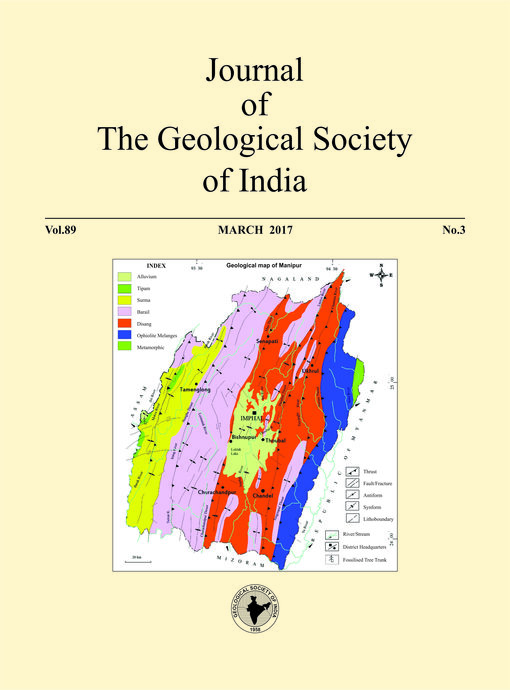Hill Slope Stability Analysis using Two and Three Dimensions Analysis: A Comparative Study
DOI:
https://doi.org/10.1007/s12594-017-0602-2Abstract
Slope instability is very common phenomenon, especially in tectonically active hills of the lesser Himalaya. The deformed, weathered and fragile rocks of the lesser Himalaya are often vulnerable under natural or anthropogenic influences. There were several cases of slope failure along highway sections in Uttarakhand Himalaya. The study was carried out along a highway section of NH-109. The factor of safety (FoS) is commonly most acceptable parameter that analyses the health of slopes. The two dimensional (2D) numerical analysis techniques are commonly used to obtain the FoS. It is observed that many times FoS obtained from 2D analysis techniques do not qualify the actual conditions and are usually lower in value as compared to ground conditions. This, in turn, increases the cost of remedial measures used for protection of slopes. This paper presents a comparative study of 2D and 3D numerical analysis based on the finite difference method (FDM) using fast Langrangian analysis of continua (FLAC) codes. The study indicates that there is no appreciable difference between FoS values obtained from 2D and 3D analysis based on the selected slope conditions. The difference ranges from 0.02 to 0.07 for analysed cases in uniform rock mass. The study also exhibits some of the important analytical observations and effects of variables on resultant FoS.Downloads
Metrics
Issue
Section
Downloads
Published
How to Cite
References
Ahmad, M., Umrao, R.K., Ansari, M., Singh, R. and Singh, T.N. (2013) Assessment of Rockfall Hazard along the Road Cut Slopes of State Highway-72, Maharashtra, India. Geomaterials, v.3(1), pp.15-23. DOI: 10.4236/gm.2013.31002.
Cala, M., Flisiak, J. and Tajdus, A. (2004) Slope stability analysis with modified shear strength reduction technique. Proc. Landslides'04, Rio de Janeiro.
Chang, Y.L. and Huang, T.K. (2005) Slope stability analysis using strength reduction technique. Journal of the Chinese Institute of Engineers, v.28(2), pp. 231-240.
Coggan, J.S., Stead, D. and Eyre, J.M. (1998) Evaluation of techniques for quarry slope stability assessment. Transactions of the Institution of Mining and Metallurgy Section B-Applied Earth Science, v.107, pp. B139-B147.
Cundall, P.A. (1976) Explicit finite difference methods in geomechanics. Proceedings of the 2nd International conference on Numerical methods in Geomechanics Blacksburg, Virginia.
Dawson, E.M., Roth, W.H. and Drescher, A. (1999) Slope stability analysis by strength reduction. Geotechnique, v.49(6), pp. 835-840.
Flac (2003) FLAC and Numerical Modeling in Geomechanics. Proc. 3rd Int. FLAC Symp. Sudbury, Canada.
Hoek, E., Carranza-Torres, C.T. and Corkum, B. (2002) Hoek-Brown failure criterion-2002 edition. Proc. North Amer. Rock Mech. Soc.
Jing, L. and Hudson, J.A. (2002) Numerical methods in rock mechanics. Int. Jour. Rock Mech. Min. Sci., v.39, pp.409–427.
Kumar, G. and Agrawal, N.C. (1975) Geology of the Srinagar-Nandprayag area (Alakananda Valley), Chamoli, Garhwal and Tehri Garhwal districts, Kumaun Himalaya, Uttar Pradesh. Himalayan Geol., v.5, pp.29-59.
Kumar, G. (2005) Geology of Uttar Pradesh and Uttaranchal. Geol. Soc. Ind., Bangalore p. 383.
Mansour, Z.S. and Kalantari, B. (2011) Traditional Methods vs. Finite Difference Method for computing safety factors of slope stability. Electron. J. Geotech. Eng., v.16, pp.1119-1130.
Sharma, L.K., Umrao, R.K., Singh, R., Ahmad, M. and Singh, T.N. (2017) Stability Investigation of Hill Cut Soil Slopes along National Highway 222 at Malshej Ghat, Maharashtra, India. Jour. Geol. Soc. India, v.89, pp.165-174
Singh, R., Umrao, R.K. and Singh, T.N. (2014) Stability evaluation of roadcut slopes in the Lesser Himalaya of Uttarakhand, India: conventional and numerical approaches. Bull. Eng. Geol. Environ., v.73(3), pp.845-857. DOI: 10.1007/s10064-013-0532-1.
Singh, R., Umrao, R.K. and Singh, T.N. (2013) Probabilistic analysis of slope in Amiyan landslide area, Uttarakhand. Geomat. Nat. Haz. Risk., v.4(1), pp.13-29. DOI: 10.1080/19475705.2012.661796.
Singh, T.N., Gulati, A., Dontha, L. and Bhardwaj, V. (2008) Evaluating cut slope failure by numerical Analysis - A Case Study. Nat. Haz., v.47, pp.263-279.
Sitharam, T.G. and Latha, M.G. (2002) Simulation of excavations in jointed rock masses using a practical equivalent continuum approach. Internat. Jour. Rock Mech. Min. Sci., v.39, pp.517–525.
Umrao, R.K., Singh, R., Ahmad, M. and Singh, T.N. (2011) Stability analysis of cut slopes using continuous slope mass rating and kinematic analysis in Rudraprayag district, Uttarakhand. Geomaterials, v.1, pp.79-87. DOI: 10.4236/gm.2011.13012.
Umrao, R.K., Singh, R., Ahmad, M. and Singh, T.N. (2012) Role of advance numerical simulation in landslide analysis: a case study. In: Proc. Natl. Conf. on Advanced Trends in Applied Sciences and Technology, Surat, India, 27–28 Jan, pp.590-597.
Umrao, R.K., Singh, R. and Singh, T.N. (2015) Stability evaluation of hill cut slopes along national highway-13 near Hospet, Karnataka, India. Georisk, v.9(3), pp.158-170. DOI: 10.1080/17499518.2015.1053494.

 Rajesh Singh
Rajesh Singh






